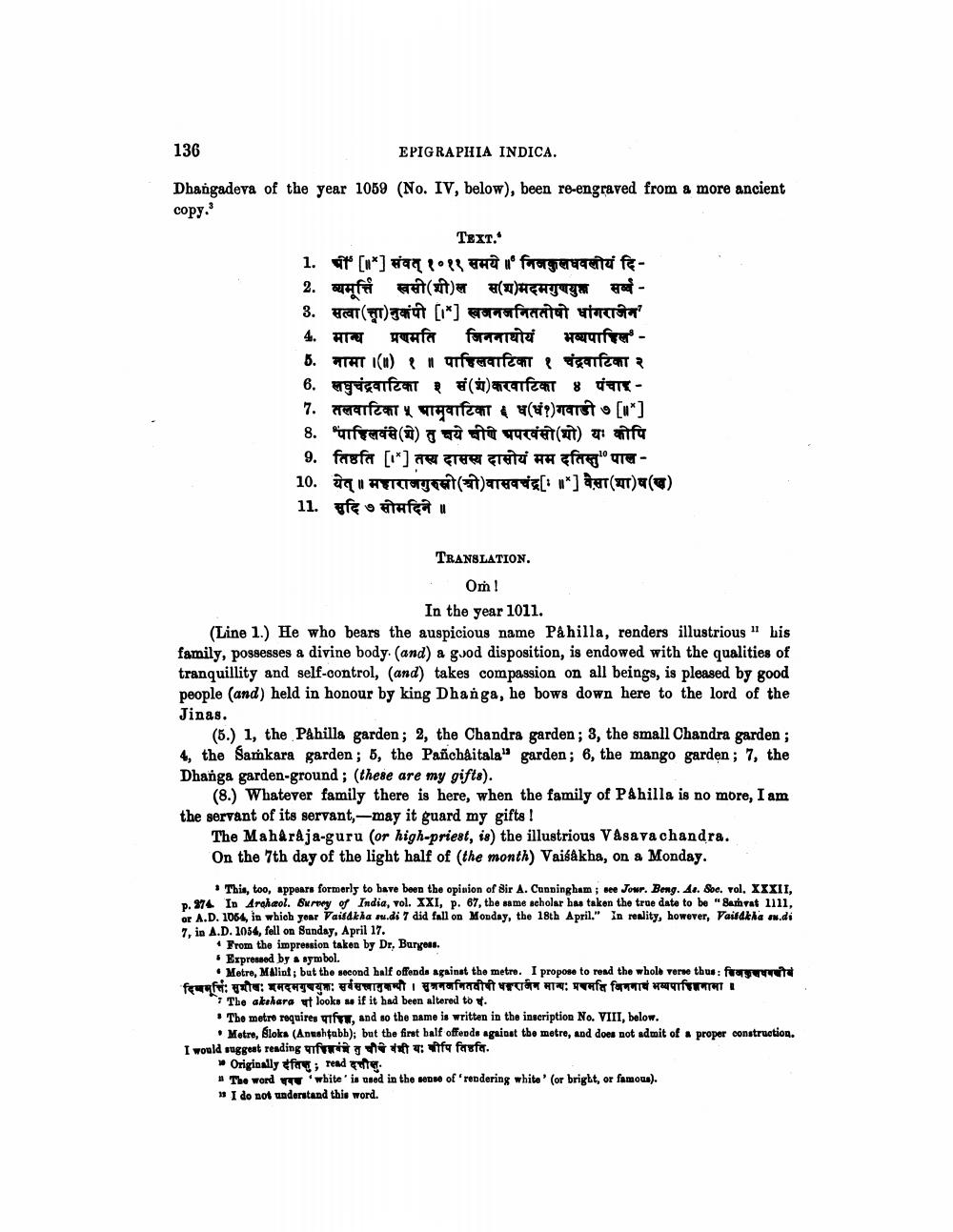________________
136
EPIGRAPHIA INDICA.
Dhangadeva of the year 1059 (No. IV, below), been re-engraved from a more ancient copy.
Text.
1. पी [*] संवत् १०१५ समये । निनकुलधवलीयं दि2. व्यमूर्ति खसी(शी)ल स(श)मदमगुणयुक्त सर्व
सत्वा(ता)नुकंपी [*] खजनजनिततोषो धांगराजन'
मान्य प्रणमति जिननाथोयं भव्यपारिस - b. मामा (३) १ ॥ पाहिलवाटिका १ चंद्रवाटिका २ 6. लघुचंद्रवाटिका ३ सं(श)करवाटिका ४ पंचार7. तलवाटिका ५ पामवाटिका । ध(?)गवाडी ७ [*] 8. "पाहिलवंसे (थे) तुपये वीणे पपरवंसो(यो) यः कोपि 9. तिष्ठति [*] तस्य दासस्थ दासोयं मम दतिस्तु पाल10. येत्। महाराजगुरुनी(श्री)वासवचंद्र[1] वैसा(या)ष(ख) 11. सुदि ७ सोमदिने ।
TRANSLATION.
Om!
In the year 1011. (Line 1.) He who bears the auspicious name Pahilla, renders illustrious in his family, possesses a divine body. (and) a guod disposition, is endowed with the qualities of tranquillity and self-control, (and) takes compassion on all beings, is pleased by good people (and) held in honour by king Dhanga, he bows down here to the lord of the Jinas.
(5.) 1, the Pahilla garden; 2, the Chandra garden; 3, the small Chandra garden ; 4, the Samkara garden; b, the Palichaitala" garden; 6, the mango garden; 7, the Dhanga garden-ground; (these are my gifts).
(8.) Whatever family there is here, when the family of Pahilla is no more, Iam the servant of its servant,-may it guard my gifts!
The Maharaja-guru (or high-priest, is) the illustrious Vasavachandra. On the 7th day of the light half of the month) Vaisakha, on a Monday.
• This, too, appears formerly to have been the opinion of Bir A. Canningham ; see Jour. Beng. 4.. Soc. vol. XXXII, p. 374. In Arohaol. Surry of India, vol. XXI, p. 67, the same scholar has taken the true date to be "Bayat 1111, or A.D. 1064, in which year Taifdkha su.di 7 did fall on Monday, the 18th April." In reality, however, Vaildkha sv.di 7, in A.D. 1034, fell on Sunday, April 17.
From the impression taken by Dr, Burgess. • Expressed by saymbol.
• Metro, MAlint, but the second half offonds against the metre. I propose to read the whole verse thus: fuar da दिबमतिः सुमौषममदमगुपयुक्तः सर्वसत्वानुकायो । सुजनननितवीषी धनराजन मान्यः प्रचमति जिमनाचे भव्यपाहिजनामा ।
The akehara at looks w if it had been altered to . The metro requires gify, and so the name is written in the inscription No. VIII, below.
• Metre, Sloka (Anushtabb); but the first balf offends against the metre, and does not admit of a proper construction. Iwould ruggent rending पापियो तुचीचे बंभी या बीपि विति.
"Originally देति; read दचीसु.
The word 'white' is used in the sense of 'rendering white' (or bright, or famous). » I do not understand this word.




